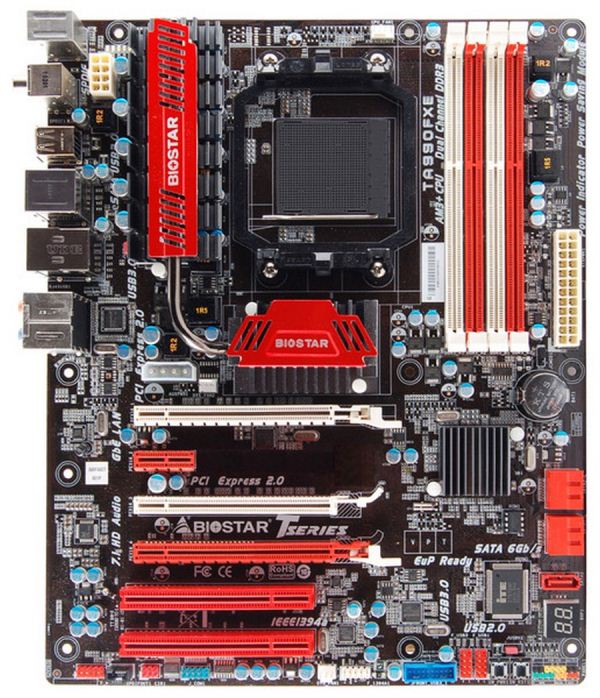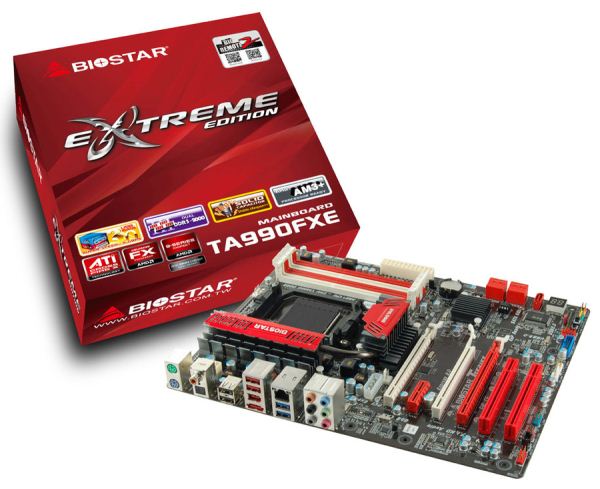990FX Motherboard Roundup with Thuban and Bulldozer – A Second Wind for ASUS, Gigabyte, MSI and Biostar
by Ian Cutress on April 5, 2012 11:00 AM ESTBiostar TA990FXE
Coming in at the cheapest 990FX board of this roundup, we have AnandTech’s first Biostar board in almost a year and a half. To me, as an enthusiast, when I hear the name ‘Biostar’, certain adjectives come to mind – the most prominent of which is ‘inexpensive’. As a home system builder and enthusiast, I have come across Biostar offerings when looking at motherboards online, and they are usually quite cheap. At those prices, I always think there is a catch – either the design may not be the best, or perhaps the warranty or support could be a dodo. I plan to cover more of Biostar's boards in the future, so from here on out I plan to put all the prejudice aside and concentrate on what matters – does it do what it says on the tin, would home users want it, and is it worth the money?
Overview
$130 is not a lot for a motherboard in the 990FX space. It comes in at the cheapest board in this multi-board review, and judging on an overview of the results and features, people might be inclined to agree.
The PCIe layout, for example, is not well thought out - the manual contradicts the layout of the board by stating that the full-length PCIe slots 1 and 3 are the primary GPU outputs, but in reality, dual GPUs should be placed in full-length PCIe slots 1 and 2. SATA ports are split between the main ones and eSATA, leaving five internal SATA ports rather than using another controller. The LAN port is non-standard as most other manufacturers use a Realtek solution, here we have the Atheros AR8151, even with Realtek ALC892 audio on board.
For the most part, performance wise, the board is down in terms of pure computation, repeatedly coming in the bottom half of most of our CPU based tests - in particular, it comes bottom of our DPC Latency tests by quite a long way. However it makes a resurgence in the GPU tests, coming near the top in almost every GPU test on both AMD and NVIDIA, single card or dual card. Overclocking was reasonable and straightforward, with a variety of auto overclock settings, although the board refused to push the CPU base frequency to the level of the other boards in this review.
The package may not include much, but the software is easy to use for overclocking, and the BIOS update utility automatically pulls the latest BIOS from online and updates the system. Users will be partially confused though by what Biostar calls 'GPU', or Green Power Utility, designed to lower the power of the system. This sort of acronym is not good. The BIOS was easy to work with and befits the style of the board, though there are a few things that could have been moved to slightly easier places to find.
At this price, compared to the other products in the review, I expected this board to not perform well or even reasonably ok in comparison. It may not have the top of the line features like the others, or the applicable software or updates, but for a board that you just need to put a processor in, it works wonderfully.
Visual Inspection
Red and white is the order of the day with the Biostar TA990FXE, on top of a black PCB with a multi-colored headers at the bottom of the board. Personally I think it does not work that well - there needs to be an element of complimentary blending, and that includes the PCB and headers. However the heatsink design looks relatively well constructed, with a lot of surface area and we again see the two heatsinks connected via a heatpipe. In contrast, the chipset heatsink is quite poor, being very small and bland. Either minimal effort was put in, or having a plain heatsink cuts down on the bill of materials.
There looks to be plenty of space around the socket for air coolers, however fan headers are few and far between. I do not think I have ever seen less than four or five on a full sized ATX board before, but Biostar take the (coveted) title by only having three. The 4-pin CPU fan header is located above the socket, a 3-pin system header is found to the bottom left of the socket almost in the center of the board, and the final 3-pin is at the bottom of the board. To be honest, this amount of fan headers is absolutely woeful. It does not instil confidence in their fan software, or the quality of the fan controllers.
Working through the board down the right hand side, Biostar has taken an oddball approach by separating the six SATA 6 Gbps ports from the chipset into two sets of two, then one straight up out of the board. That is five, and the sixth is no-where to be seen. You might consider it as an eSATA in the IO panel, but that is technically listed as 3 Gbps, which begs the question why it was downclocked. Biostar are paying for the chipset, so it seems a little wasteful to restrict the consumers’ use of all of it when there is plenty of space on the board.

What is good to see on this board though is a two-digit debug LED and a set of power and reset buttons. This gives us a perfect excuse to question Gigabyte who does not have them on a motherboard that is $50 more expensive. Back to the Biostar, and they have crammed enough on the bottom of the board such that the USB 2.0 headers are at 90 degrees to other manufacturers representations. Alongside the USB 2.0 headers, we also have a USB 3.0 header, a COM header, and front panel audio.
The PCIe layout is another oddball bit of design that stinks of laziness. In order, we have a 4-pin molex connector, an x16, x1, x16, x4, PCI, PCI. The 4-pin molex is there usually to provide more power to the PCIe slots, though it is in a really awkward place, as users will have to route over the CPU cooler or over GPUs to put something in it. The whole layout as well has me scratching my head – if I want a dual GPU setup, then there is no space between the cards, which makes my top card run very hot. Do we really need access to two PCI slots and no PCIe x1 when running dual GPUs? I wonder who came up with that layout – sure it is easier in terms of routing traces around the board, but it is bad from just a functionality point of view when you have space to spare.

The back panel is sparse, which again is probably attributable to the price. Alongside a pair of PS/2 ports, we get dual S/PDIF outputs, two USB 2.0 in black, two USB 2.0 in red, IEEE1394, an eSATA, two USB 3.0 in blue, Atheros AR8151 gigabit Ethernet, and audio outputs via a Realtek ALC892. More questions arise – we know that Realtek sell an audio/NIC combo at a low price, so why ditch that and get in the Atheros? Is it cheaper? What does that mean to the consumer? Hopefully I will get to the bottom of it.












57 Comments
View All Comments
phys1cs - Thursday, April 5, 2012 - link
Spamming affiliate links, I see.R3MF - Friday, April 6, 2012 - link
"The third generation FX processor, codename Steamroller, is still reported (not confirmed) to use AM3+, meaning that there are still quite a few years left in this platform when taking the AMD route."If this is true then i simply cannot believe that AMD will continue on socket AM3+ without a chipset that supports PCIe 3.0!
Where, when, and what will the 1090FX chipset arrive?
SilthDraeth - Thursday, April 5, 2012 - link
This seems to be an ok roundup of AMD boards.However, how do the latest Windows 7 tweaks increase the performance of the Bulldozer? Can we get a before and after benchmark based on Win 7 and or Win 8 (beta) optimizations?
I was hoping we would get that information. Also, how does it compare to similarly priced Intel offerings?
IanCutress - Thursday, April 5, 2012 - link
Thank you for your comment. I didn't perform comparisons as Anand did a comprehensive look at the scheduling updates here:http://www.anandtech.com/show/5448/the-bulldozer-s...
(Also reviewing five boards and writing 20,000 words about them takes longer than you think!)
If there are any motherboards you would like to see in the future (or particular tests), drop me an email (ian AT anandtech.com) and I will have a look. Obviously I can't take care of every little niche test that everyone wants, otherwise we'd only get one board a month out for review, but I'll do what I can!
Ian
SilthDraeth - Thursday, April 5, 2012 - link
Thank you for the link. That is what I wanted.StevoLincolnite - Thursday, April 5, 2012 - link
I noticed your Thuban was hitting 60'C+So I was just wondering if you took the Thubans thermal bug into account on those readings? On my old 1090T and 1045T I had to have a 13'c offset to get a correct thermal reading.
sumitlian - Saturday, August 4, 2012 - link
Temperature related problem have long been rectified in C3 stepping of Denab CPUs and in Thuban as well. There is no fault in temperature sensor anymore in our CPUs.Only C2 rev. or earlier rev. AMD CPUs suffered from this issue.
Download and Read:
"Revision Guide for Family 10h CPU"
ExarKun333 - Thursday, April 5, 2012 - link
More to life than gaming on your PC. If you read the article, you could see how terrible the non-gaming benchmarks are for 'only' a Intel 4 and 6-core vs the 8-core AMD. Fanboi much?blazeoptimus - Thursday, April 5, 2012 - link
I bought an MSI 990FX-GD80 board a couple of months ago and was looking for a review like this one at the time. I would have loved the info you brought up here and I hope it will help others looking into the available 990FX boards.I went with the MSI board since it seemed to hit a sweet spot on features, price (newegg was offering $20 off which put it to $169) and performance. I also went with a Zosma processor since it seemed to hit the price elbow and had the most unlocking potential. I've been very happy with the experience thus far. I've been able to unlock the 2 additional processors and have pushed the clock to 3600mhz (stock is 3k). My next push will be to see if I can hit the aggressive clocks listed in this article.
Thanks again for the write up. I'm a long time reader and frequently use the information in these reviews to make hardware decisions.
Taft12 - Thursday, April 5, 2012 - link
Very comprehensive, thank you Ian!Of course now that you've exhausted so much energy on this review, the 1090FX chipset is right around the corner alongside the 2nd gen FX CPUs.
Such is life for a desktop hardware reviewer!